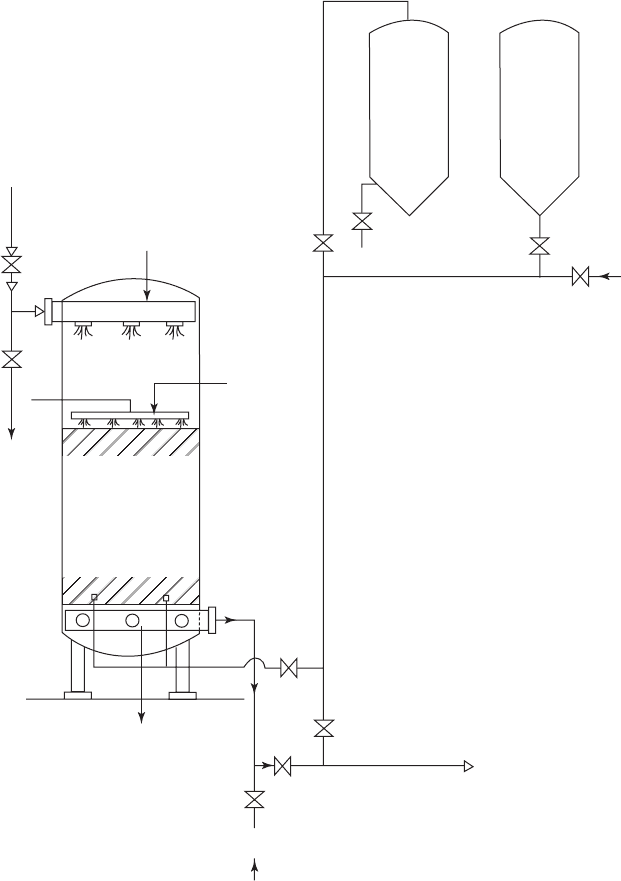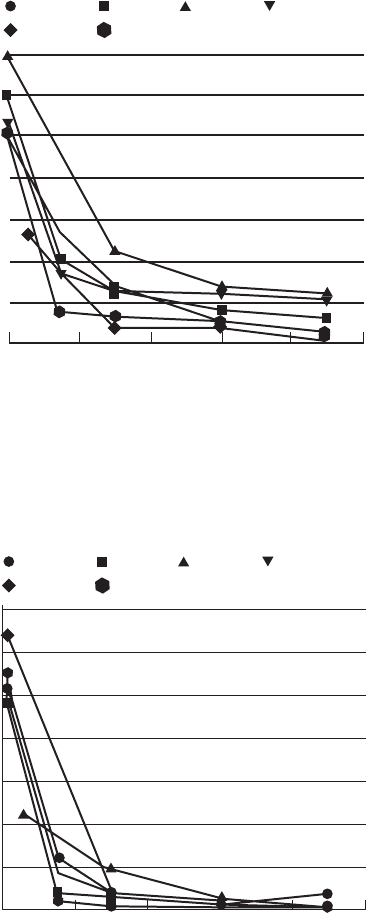Water and Wastewater Engineering
Подождите немного. Документ загружается.


14-30 WATER AND WASTEWATER ENGINEERING
Example 14-3. Determine the Freundlich isotherm constants K and n for the following
e xperiment (adapted from LeGrega et al., 2001).
One hundred milliliters of a 600 mg/L xylene solution is placed in each of five containers
with different amounts of activated carbon and agitated for 48 hours. The samples are filtered,
and the amount of xylene is determined as shown below.
Container 1 2 3 4 5
Carbon, mg 600 400 300 200 50
Xylene remaining,
mg/L
25 99 212 310 510
Solution.
a . Calculate q
e
.
m, g C
e
, mg/L x, mg q
e
, mg/g
0.6 2557.5 95.8
0.4 99 50.1 125.3
0.3 212 38.8 129.3
0.2 310 29.0 145.0
0.05510 9.00 180.0
The quantity in the column marked “ m ” is the mass of carbon in grams instead of mg
given in the data set. C
e
i s given in the data set. The value of “ x ” is computed as fol-
lows:
x
CC
e
()()
0
V
where C
0
i s the initial concentration and
V
i s the volume of solution in liters. In this case,
that is 0.100 L. The value q
e
x / m.
b. A spreadsheet is used to plot C
e
versus q
e
and find the trendline equation,
qC
ee
51 3
0 187
.
.
()
With the is otherm data, a feasibility comparison of several carbon types can be m ade. The
feasibility estimate must assume a batch reaction that comes to equilibrium at the same tempera-
ture used for the isotherm.
Example 14-4. Use the isotherm data from Example 14-3 to m
ake a gross estimate of the daily
carbon usage required to treat a highly contaminated well serving a small village. The demand is
380 m
3
/ d. The water is contaminated with 60 mg/L of xylene. The MCL is 10 mg/L. Assume that
a batch reactor will be used that will operate at the same temperature and pH as the laboratory
experiment and that the slurry will be mixed until equilibrium is achieved.

REMOVAL OF SPECIFIC CONSTITUENTS 14-31
Solution:
a . From the Freundlich equation developed in Example 14-3 with C
e
10 mg/L,
q
e
5 1 3 10 78 9
0 187
..
.
mg xylenes/g carbon()
b. Mass of xylene to be removed per day:
()()()60 10 380 1 000 1 9
33
mg/L mg/L m /d L/m,.0010
7
mg/d
c. Mass of carbon required:
190 10
78 9
7
.
.
mg/d of xylene to be removed
m
ggxylenes/g carbon
g/d or kg/2 41 10 240
5
. ddof activated c arbon
A ctual designs should be based on column studies using the actual raw water becaus e the
behavior of the GAC column will not reach equilibrium in normal practice. The mass balance
method presented for designing ion exchange columns (Chapter 8) can be used to evaluate the
column data and develop a design.
The usual systems to contact the water with the carbon are fixed beds and countercurrent
moving beds (also called pulsed beds ). The fixed beds may be operated in either the upflow or
downflow configuration. The upflow, fixed bed is more efficient in carbon use but require
s a
relatively high influent clarity ( 2–3 NTU). The downflow configuration may also s erve as a
filter for suspended solids. The countercurrent moving beds have a lower labor cost and higher
utilization of the adsorption capacity of the carbon. Both the fixed beds and the moving beds may
use gravity or pressure liquid flow. A ty
pical fixed-bed column with liquid downflow is shown
in Figure 14-9 . In practice, multiple beds in series, parallel, or a combination of series and paral-
lel are used. A minimum of two in series is recommended to optimize carbon use and prevent
premature breakthrough.
The particle size of the GAC affec
ts pressure drop, filtration efficiency, and the rate at which
equilibrium is reached. Smaller particles yield a higher pressure drop but reach equilibrium more
rapidly. Selection of the GAC particle size is then a matter of balancing these competing issues.
Table 14-10 provides a guide to selection for the variou s possible c
olumn configurations.
Typical design criteria are listed in Table 14-11 on page 14-34.
Carbon regeneration is a major consideration in the selection and design of GAC facili-
ties. An extensive discussion of the options and operational considerations is given in Clark and
Lykins (1989).
14-12 TASTE AND ODOR (T&O)
T a ste and odor are grouped together because they are inextricably linked. Although taste and
odor are not classified as “spec ific constituents,” they arise from specific constituents and are,
therefore, included in this chapter. The major water treatment issue with T&O is palatability
rather than potability.
Decaying vegetation and metabolites of microorganisms are the most universal sourc es
of d isagreeable taste and odors in surface water. T&O problems are more common in surface
water than groundwater becaus e of the presence of algae in surface water. The rotten egg odor
of hydrogen sulfide occurs
in groundwater, and in som e distribution systems, as a result of the

14-32 WATER AND WASTEWATER ENGINEERING
Treated
transport water
Regenerated carbon
inventory tank
Spent carbon
drain tank
Drain
Influent
Surface
wash
Influent
distributor
Carbon
bed
Waste
Underdrain
system
Transport water
Wash
water
Effluent
Carbon slurry line
FIGURE 14-9
Single column, fixed bed carbon adsorption system.
anaerobic conversion of sulfates. Other sources of taste and odor are metals (zinc, copper, iron,
and manganese) and solvents.
Treatment Strategies
Chemical oxidation and activated carbon adsorption are the most common methods of reducing
T&O.

REMOVAL OF SPECIFIC CONSTITUENTS 14-33
TABLE 14-10
Guide to selection of GAC adsorption system configuration
System configuration Use when:
Single fixed bed; downflow Low carbon use rate (CUR) is anticipated because
of low contaminant concentrations and low flow
rate
Fixed bed in series;
a
downflow
High CUR anticipated; high effluent quality
required
Fixed beds in parallel;
b
downflow
Large total flow rate; pressure drop minimization
is required
Expanded beds; upflow Suspended solids are to be removed in subsequent
process; low CUR is anticipated because of low
contaminant concentrations and low flow rate
Moving or pulsed beds; upflow High CUR anticipated; high effluent quality
required; either some carbon fines can be tolerated
in effluent or carbon adsorption is followed by
filtration
a
Capital cost generally limits number of columns to four or less.
b
M o st appropriate for large plants; spare column is provided to allow carbon regeneration at design
capacity; CUR is increased by staggered start and blending of effluent which allows beds to operate
until exhausted.
Sources: Brady, 2005; Fornwalt and Hutchins, 1966; Rizzo and Sheperd, 1977; Zanitach, undated.
Chemical Oxidation. Chlorine is effective in oxidizing odors associated with reduced sulfur
compounds. It is less effective in destroying odors resulting from phenolic and other organic
compounds. In addition, chlorination of organic compounds may result in the formation of dis-
infe
ction byproducts.
Chlorine dioxide, ozone, and permanganate have been used successfully to reduce T&O.
Because of the great variety of sou rces of T&O, careful experimentation with these oxidants is
warranted as the oxidation products may be more odorous than the original compou
nd.
Activated Carbon. Both granular and powdered activated carbon (GAC and PAC) have
been used successfully for T&O control. In a 1989 survey, Suffet et al. (1996) found 63 per-
cent of the water treatment plants used PAC for T&O control. The majority of surface water
episodes are of one to two weeks duration. The convenience of PAC is that it can be added
periodi
cally in a conventional surface water treatment plant when T&O arises due to algal
bloom. PAC is generally added in one of four locations: at the water intake, in the rapid mix
tank, at the filter inlet, and in a separate slurry mixing tank. The intake addition provides a
long contact time but may interfere with preoxidation for NOM removal. The rapid mix tank
provides good mixing, bu
t the coagu lant may interfere with the adsorption of the T&O. Addi-
tion of the PAC jus t ahead of the filter makes efficient use of the PAC but may resu lt in filter
breakthrough of the fines. Doses range from a few to 100 mg/L with typical doses in the 0.5
to 18 mg/L range (Graham et al., 2000). Experiments conducted by Huang et al. (1996) on
the reduction of 2-methylisoborneol (MIB) and geosmin, two comm
on sources of T&O in

14-34 WATER AND WASTEWATER ENGINEERING
surface water, demonstrate the need to examine alternative carbon sources and contact times
( Figures 14-10 and 14-11 ).
GAC is placed in a packed bed. GAC is used in about 7 percent of the plants for T&O control
(Suffet et al., 1996). For continuous T&O control from groundwater, GAC is preferred becau
se
much less is required than if PAC is used. Because of the wide variety of experience in the
sources of T&O, pilot scale data are the best resource for design data. A rapid small-scale col-
umn test (RSSCT) has been developed that can be used to predict pilot-scale GAC performance
( Crittenden et al., 1987). An e
xtensive discussion of the use of RSSCT and the care required in
using it for scale up are discussed in MWH (2005).
A few anecdotal data illustrate the order of magnitude design criteria (Clark and Lykins,
1989; Dvorak and Maher, 1999; MWH, 2005):
• Bed depths of 1 m are too short.
• Bed depths of 2–3 m are effective.
TABLE 14-11
Typical design ranges for GAC columns for water treatment
Parameter ValueComment
Carbon mesh size 8 30 Downflow beds and upflow
packed beds
12 40 Upflow expanded beds
Hydraulic loading rate
Single fixed column 60 to 230 m
3
/d · m
2
Parallel fixed column 60 to 230 m
3
/d · m
2
Series columns 175 to 400 m
3
/d · m
2
Moving bed 290 to 600 m
3
/d · m
2
EBCT 10 to 60 min There is a diminishing return on
time to exhaustion and CUR at
EBCTs greater than 30 min. Pilot
tests are essential.
Carbon use rate (CUR) 20 to 100 kg/1,000 m
3
Lower CURs are associated with
longer EBCTs
Column height 1 to 5 m Prefab will be sized to fit on flat
bed trailer.
Diameter 3.6 m Restriction to 3.6 m for transport
of prefab units
Height:Diameter 1:1 Without liquid redistribution
use 4:1 for proper liquid
distribution
Pressure drop 0.2 to 8 kPa/m of carbon
Backwash rate 600 to 1,200 m
3
/d · m
2
Backwash expansion 10 to 50%
Sources: Clark and Lykins, 1989; Culp et al., 1978; Reynolds and Richards, 1996; U.S EPA, 1971.

REMOVAL OF SPECIFIC CONSTITUENTS 14-35
140
120
100
80
60
40
20
0
020
40 60 80 100
Carbon A
Carbon E Carbon F
Carbon B Carbon C Carbon D
Geosmin concentration ng/L
Time-min
FIGURE 14-10
Kinetic test results for adsorption of MIB for various PACs. ( Source: Huang et al., 1996).
140
120
100
80
60
40
20
0
020
40 60 80 100
Geosmin concentration ng/L
Carbon A
Carbon E Carbon F
Carbon B Carbon C Carbon D
Time-min
FIGURE 14-11
Kinetic test results for adsorption of geosmin for various PACs. ( Source: Huang et al., 1996.)

14-36 WATER AND WASTEWATER ENGINEERING
• Effective empty bed contact times (EBCTs) are on the order of 10 to 15 minutes but may be
up to one hour.
• Normal service life is on the order of 2 to 5 years.
• Regeneration periods from 6 to 36 years have been reported with filter volume to water
flow rate ratios of 4.6 to 10.6 m
3
of carbon/1,000 m
3
of the design flow rate.
14-13 CHAPTER REVIEW
When you have completed studying this chapter, you should be able to do the following without
the aid of your textbooks or notes:
1 . Identify the oxidation state of arsenic required for it to be removed effectively.
2. Explain why it is of benefit to strip CO
2
from water that is to be softened by the lime-
soda process.
3. Identify the medium most likely to be selected to reduce the fluoride concentration in a
water supply.
4. Explain why iron and manganese are removed from a water supply.
5. Explain why nitrate is removed fro
m a water supply.
6. Explain why NOM is removed from a water supply.
7. Define the following abbreviations: EDC, SOC, VOC.
8. Explain why PAC is chosen more frequently than GAC for T&O control in plants with
surface water as their source of supply.
W ith the use of this text, you should be able to do the following:
9. Estimate the dose of a given arsenic oxidant for a water that ha
s one or more of the fol-
lowing constituents in addition to arsenic: iron, manganese, sulfide.
10. Select an appropriate arsenic treatment scheme given the raw water constituents and
their concentrations.
11. Design a stripping tower to remove CO
2
to a specified level given the water tempera-
ture.
12. Evaluate an activated alumina column design with respect to typical design criteria.
13. Select an appropriate iron and/or manganese treatment scheme given the raw water
constituents and their concentrations.
14. Evaluate alternative treatment processes to remove NOM for a given TOC concentra-
tion in a raw water and
existing treatment train.
15. Recommend several alternatives to evaluate for removal of radon, radium, or uranium
in a raw water.
Visit the text website at www.mhprofessional.com/wwe for supplementary materials
and a gallery of photos.
REMOVAL OF SPECIFIC CONSTITUENTS 14-37
16. Evaluate a preliminary design of a GAC column for T&O control in groundwater.
17. Design a stripping tower to remove a VOC to a specified level given the Henry’s law
constant, overall transfer rate constant, and water temperature.
18. Compute the Freundlich equation constants using experimental data.
14-14 PROBLEMS
14-1. Estimate the stoichiometric amount of permanganate in mg/L required to oxidize
arsenic in groundwater with the following constituents:
A s(III) 50 g/L
Fe(II) 2.0 mg/L
Mn(II) 0.5 mg/L
Note: Redox half reactions are given in Table 13-1.
14-2. Estimate the stoichiometric amo
unt of ozone in mg/L required to oxidize arsenic in
groundwater with the following constituents:
A s(III) 100 g/L
Fe(II) 12.0 mg/L
H
2
S 0.2 mg/L
Note: Redox half reactions are given in Table 13-1.
14-3. Select an arsenic treatment system for a groundwater with the following
characteristics:
A s
5
48 g/L
Cl
102 mg/L
F
1.0 mg/L
Fe
3
0.3 mg/L
H
2
S N/D
*
M n
4
0.01 mg/L
NO N/D
3
∗
pH 7.0
PO N/D
4
3
∗
Silica 12 mg/L
SO mg/L
4
2
20
TDS 225 mg/L
TOC 0.1 mg/L
*
N/D not detected
14-4. Select an arsenic treatment system for groundwater with the following
characteristics:
A s
5
88 g/L
Cl
260 mg/L
F
1.0 mg/L
Fe
3
1.2 mg/L
H
2
S 0.3 mg/L
14-38 WATER AND WASTEWATER ENGINEERING
M n
4
0.2 mg/L
NO mg/L
3
10.
pH 6.3
PO N/D
4
3
∗
Silica 24 mg/L
SO mg/L
4
2
100
TDS 412 mg/L
TOC 3.0 mg/L
*
N/D not detected
14-5. Determine the number of trays for a multiple tray aerator to reduce the CO
2
concen-
tration in Eastwood Manor’s raw water supply from 20.9 mg/L to 6.2 mg/L as CO
2
.
The following design criteria have been developed for this project: Q 5,450 m
3
/ d,
temperature 5 C.
14-6. Determine the number of trays for a multiple tray aerator to reduce the CO
2
concen-
tration in Magnolia’s raw water supply from 27.8 mg/L to 4.0 mg/L as CO
2
. The
following design criteria have been developed for this project: Q 10,600 m
3
/ d,
temperature 5 C
14-7. Select an iron/manganese removal system for the village of Ferric. The design flow
rate is 3,800 m
3
/ d. The raw water characteristics are:
Fe(II) 5.0 mg/L
Mn(II) 0.0 mg/L
H
2
S N/D
*
NH
3
N/D
*
TOC N/D
*
*
N/D not detected
14-8. Select an iron/manganese removal system for the town of Many Farms. The design
flow rate is 7,600 m
3
/ d. The raw water characteristics are:
Fe(II) 15.0 mg/L
Mn(II) 0.1 mg/L
H
2
S 1.0 mg/L
NH
3
1.3 mg/L
TOC 4.0 mg/L
D i ssolved oxygen N/D
*
*
N/D not detected
14-9. Design a stripping column to reduce the trichloroethylene concentration in Oil City’s
raw water supply from 6.0 mg/L to 1.5 g/L. The following design criteria have been
developed for this project.
Q 6,500 m
3
/ d
T e mperature 10 C

REMOVAL OF SPECIFIC CONSTITUENTS 14-39
P a cking 90 mm tripacks
H 0.237
K
L
a 0.72 min
1
P/Z 50 Pa/m
g
1.2 kg/m
3
w
1,000 kg/m
3
Determine the following to complete the design:
Q
a
/ Q
Q
a
Column diameter
Stripping factor
Height of packing
Overall height of packed tower
14-10. Design a stripping column to reduce the tetrachloroethylene concentration in Carbon
Hill’s raw water supply from 56.9 g/L to 5.0 g/L. The following design criteria
have been developed for this project.
Q 6,500 m
3
/ d
T e mperature 10 C
P a cking 90 mm tripacks
H 0.364
K
L
a 1.3 min
1
P/Z 50 Pa/m
g
1.2 kg/m
3
w
1,000 kg/m
3
Determine the following to complete the design:
Q
a
/ Q
Q
a
Column diameter
Stripping factor
Height of packing
Overall height of packed tower
14-11. Determine the Freundlich isotherm constants for the following experimental data for
methylene chloride. The initial concentration was 8.4 g/L and the sample volume
was 1.0 L.
Container 1 2 3 4 5 6
Carbon, mg45 120 360 1,100 1,400 1,600
CH
2
Cl
2
remaining, g/L
7.1 5.5 2.9 0.89 0.75 0.60
14-12. The following Freundlich isotherm constants were obtained for adsorption of toluene
on activated carbon. Plot the isotherm curves for each, and determine which of these
appears to be the better choice for further examination in column studies.
